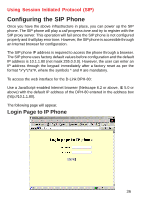D-Link DPH-80 Manual - Page 35
Using Session Initiated Protocol (SIP
 |
View all D-Link DPH-80 manuals
Add to My Manuals
Save this manual to your list of manuals |
Page 35 highlights
Using Session Initiated Protocol (SIP) IP Phone Configuration Infrastructure Requirements Although the DPH-80 SIP phone will work in any type of LAN network, a 100mbps, switched network is more suitable for providing good quality voice communications. SIP phones need a proxy or redirect server to provide the directory function required to make calls. D-Link SIP phones register the assigned phone number with the server on power up. However, D-Link SIP phones can work through the phone book without an SIP server. To operate properly, the DPH-80 requires a set of IP parameters such as IP address, subnet mask, gateway address, and DNS server address. These parameters can be configured either statically through a browser or dynamically through DHCP or PPPoE. A DHCP server in the local LAN is required to provide these parameters. The D-Link SIP phone has many configurable parameters. These parameters can be configured through any Java-enabled Internet browser (Netscape 6.2 or above, IE 5.0 or above). If your LAN network has a firewall and NAT, they should support SIP to make and receive calls from outside your LAN network. A TFTP server is required to support remote software upgrades. Please check with your service provider for further information on upgrading your device. 35















